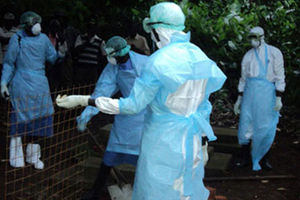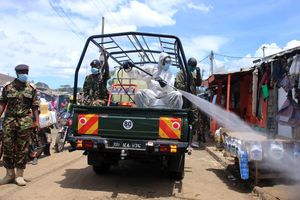Health experts on high alert for virus feared to be the next big pandemic

A health worker leaves an isolated area on April 10, 2005 in Uige, about 300km north of the capital, Luanda, Angola in a makeshit tent where Marburg-virus suffering local residents are treated.
What you need to know:
- Early symptoms include high fever, severe headache, diarrhoea, vomiting and stomach-ache, which intensifies with time.
- However, it is quite difficult to differentiate Marburg from other tropical diseases such as malaria and Ebola in its initial stages.
The World Health Organization (WHO) is re-examining samples of a highly contagious virus feared to be the ‘next big pandemic’.
Health experts are on high alert over a potential eruption of the lethal Marburg virus, which has killed two people in Ghana.
The two patients with no close interactions succumbed to the virus described by WHO as ‘epidemic prone’, indicating that it is spreading fast.
The victims from Ashanti region, Southern Ghana, whose sex and ages are yet to be revealed, suffered from symptoms such as fever, diarrhoea, nausea and vomiting, according to medics.
WHO, which has since embarked on re-examining the samples, has deployed health officials to trace the victims’ close contacts as well as offer support to Ghanaian medics.
Health officials in the West African nation say 98 people are now under quarantine as suspected contact cases.
“Health experts are already investigating the ground situation and also preparing how to tackle a probable flare-up. We are working with the government closely to prepare how to curb the virus spread, reinforce detection and track contacts,” said WHO official in Ghana, Dr Francis Kasolo.
The two patients are the first-ever cases of the disease in Ghana. However, it is the second time it is being reported in the West Africa continent following a minor outbreak last year in Guinea. Other countries where the virus has been linked to outbreaks include Democratic Republic of Congo , Angola, South Africa, Uganda and Kenya. The virus killed more than 200 people in Angola in 2005, the deadliest outbreak on record, according to WHO.
In efforts to contain the virus, which requires exceptionally stringent measures of infection control, WHO has heightened surveillance through tracking close contacts and testing.
Further, it has sent out officials to spread community awareness, educate and alert the public on the dangers of Marburg disease as well as partner with emergency response teams. Marburg is a lethal haemorrhagic illness classified in the same family with the infamous Ebola virus disease, according to WHO.
It is highly contagious and often eliminates almost if not all its victims – it has a case fatality ratio of up to 88 per cent.
Early symptoms include high fever, severe headache, diarrhoea, vomiting and stomach-ache, which intensifies with time. However, it is quite difficult to differentiate Marburg from other tropical diseases such as malaria and Ebola in its initial stages.
Patients also bleed from multiple openings including eyes, nose, gums and vagina.
The symptoms such as severe headaches and high fever start immediately and normally evolve to severe bleeding, which can go up to seven days.
It’s main symptoms include patients exhibiting ‘ghostlike’ appearance characterised by expressionless faces and deep set eyes.
Eventually, patients die from failure of the nervous system.
While WHO estimates Marburg’s fatality rate at 50 per cent, previous outbreaks have had varied fatality rates ranging from 24 per cent to 88 percent. Currently, there is no approved cure for the illness and medics use intravenous drips to monitor and treat patients.
According to the health authority, antiviral and vaccine treatments are being trialled in a number of studies and can only be administered as part of the experiments.
Scientists are still racking their brains trying to develop various potential cures such as drug therapies, immune therapies and blood products.
It is essentially passed to human beings through exposure to caves and mines inhabited by Rousettus bats also known as fruit bats.It can also be transmitted between humans through touching contaminated surfaces, bodily fluids and blood.
The disease was first detected among humans after outbreaks in Frankfurt and Marburg in Germany, Serbia and Belgrade, in 1967.
This was after the disease was passed by monkeys imported from Uganda to laboratory workers. Decades later in 2008, it was detected for a second time in a Dutch woman who returned to the Netherlands from visiting caves in Uganda.





